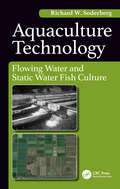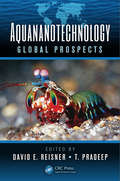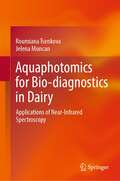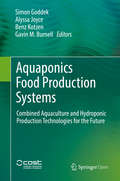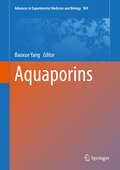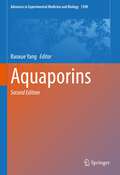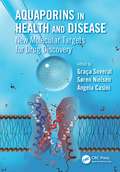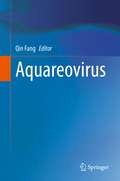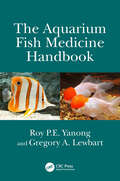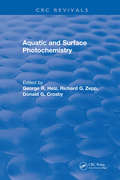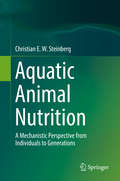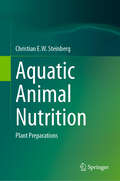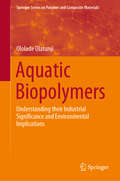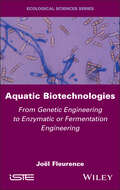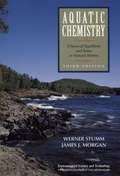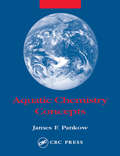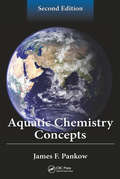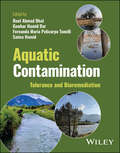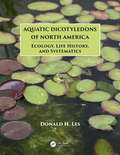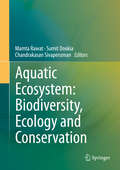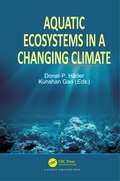- Table View
- List View
Aquaculture Technology: Flowing Water and Static Water Fish Culture
by Richard Soderberg W.Key features: Takes a quantitative approach to the science of aquaculture Covers the complete landscape of the scientific basis of fish culture Promotes problem solving and critical thinking Includes sample problems at the end of most chapters Guides the reader through the technical considerations of intensive aquaculture, including fish growth rates, hydraulic characteristics of fish rearing units, oxygen consumption rates in relation to oxygen solubility and fish tolerance of hypoxia, and water reconditioning by reaeration and ammonia filtration. Discusses the environmental effects of aquaculture Includes a chapter on hatchery effluent control to meet receiving water discharge criteria Aquaculture Technology: Flowing Water and Static Water Fish Culture is the first book to provide the skills to raise fish in both a flowing water and a static water aquaculture system with a pragmatic and quantitative approach. Following in the tradition of the author’s highly praised book, Flowing Water Fish Culture, this work will stand out as one that makes the reader understand the theory of each type of aquaculture system; it will teach the user "how to think" rather than "what to think" about these systems. The book presents the scientific basis for the controlled husbandry of fish, whether it be in a stream of water or a standing water pool. Part 1, Flowing Water Fish Culture, is a major revision of the author’s initial book and includes greatly expanded coverage of rearing unit design criteria, fish growth and the use of liquid oxygen, hatchery effluent control, and recirculating systems. Part 2, Static Water Fish Culture, presents the scientific basis of fish culture in standing water systems including nutrient and dissolved gas dynamics, pond ecology, effects of fertilization and supplemental feeding, water quality management and representative static water aquacultures. Aquaculture Technology conveys the science in a manner appropriate for use by university students and teachers and others involved in fish production and aquaculture research and development worldwide. It will enable the reader to adapt to changing technologies, markets, and environmental regulations as they occur.
Aquananotechnology: Global Prospects
by David E. Reisner T. PradeepThe world's fresh water supplies are dwindling rapidly-even wastewater is now considered an asset. By 2025, most of the world's population will be facing serious water stresses and shortages. Aquananotechnology: Global Prospects breaks new ground with its informative and innovative introduction of the application of nanotechnology to the remediatio
Aquaphotomics for Bio-diagnostics in Dairy: Applications of Near-Infrared Spectroscopy
by Roumiana Tsenkova Jelena MuncanThis book is the result of more than 20 years of experience in working with near-infrared spectroscopy for raw milk analysis. The totality of this work presents extensive possibilities for milk spectral measurements that can be carried out in dairy. Moving beyond the standard milk components such as fat, protein, or lactose, this book presents near-infrared spectroscopy as a method that can also be used in disease diagnostics. The measurements and experimental results presented here are all based on the utilization of usually neglected near-infrared regions—regions with strong absorbance of water. The author has found the water – light interaction discussed to be an immensely rich source of information, not only on milk composition but also on the physiological status of the animals involved. A special section of the book is dedicated to exploration of potential interfering factors that may influence the analysis and contribute to the robustness of the models. The research described in this book served as a basis for the development of the novel discipline aquaphotomics and is of interest to anyone working in this field.
Aquaponics Food Production Systems: Combined Aquaculture and Hydroponic Production Technologies for the Future
by Simon Goddek Alyssa Joyce Benz Kotzen Gavin M. BurnellThis open access book, written by world experts in aquaponics and related technologies, provides the authoritative and comprehensive overview of the key aquaculture and hydroponic and other integrated systems, socio-economic and environmental aspects. Aquaponic systems, which combine aquaculture and vegetable food production offer alternative technology solutions for a world that is increasingly under stress through population growth, urbanisation, water shortages, land and soil degradation, environmental pollution, world hunger and climate change.
Aquaporins (Advances in Experimental Medicine and Biology #969)
by Baoxue YangThis book provides a state-of-the-art report on our current understanding of aquaporins and the future direction of the field. Aquaporins (AQPs) are a group of water-channel proteins that are specifically permeable to water and other small molecules, such as glycerol and urea. To date thirteen water-channel proteins (AQP0 - AQP12) have been cloned and the mechanisms and physiological functions of water transport across biological membranes have long been the subject of interest. Recent advances in the molecular biology and physiology of water transport have yielded new insights into how and why water moves across cell membranes, and studies on aquaporin knockout mouse models suggest that aquaporins are involved in the development of some diseases and they may be useful targets of research into selective-inhibitor drugs. By focusing on the advances made over the last 20 years in the biophysics, genetics, protein structure, molecular biology, physiology, pathophysiology and pharmacology of aquaporins in mammalian cell membranes, this book provides novel insights into further mechanisms and the physiological significance of water and some small molecule transport in mammals in order to stimulate further research in new directions.
Aquaporins (Advances in Experimental Medicine and Biology #1398)
by Baoxue YangThis book provides a state-of-the-art report on our current understanding of aquaporins and the future direction of the field. Aquaporins (AQPs) are a group of water-channel proteins that are specifically permeable to water and other small molecules, such as glycerol and urea. To date thirteen water-channel proteins (AQP0 – AQP12) have been cloned and the mechanisms and physiological functions of water transport across biological membranes have long been the subject of interest. Recent advances in the molecular biology and physiology of water transport have yielded new insights into how and why water moves across cell membranes, and studies on aquaporin knockout mouse models suggest that aquaporins are involved in the development of some diseases and they may be useful targets of research into selective-inhibitor drugs. By focusing on the advances made over the last 30 years in the biophysics, genetics, protein structure, molecular biology, physiology, pathophysiology and pharmacology of aquaporins in mammalian cell membranes, this book provides novel insights into further mechanisms and the physiological significance of water and some small molecule transport in mammals in order to stimulate further research in new directions.In the second version, fourteen chapters will be updated base on the most recent research articles. Ten new chapters will be added.
Aquaporins in Health and Disease: New Molecular Targets for Drug Discovery
by Graça Soveral S0ren Nielsen Angela CasiniSince the discovery of Aquaporin-1 (AQP1) as a water channel, many studies have revealed the importance of aquaporins in mammalian physiology and pathophysiology as well as plant and microbial biology. The studies have also shown aquaporins as potential drug targets and targets for improving crop properties.Written by an international group of contributors at the forefront of the field, Aquaporins in Health and Disease: New Molecular Targets for Drug Discovery presents the latest research advances in aquaporins and other major intrinsic protein (MIP) channels. The first section of the book describes the general concepts of aquaporin channel function, genomic research, structure-function analysis of aquaporins and glycerol facilitators, and regulation by gating and trafficking, including yeast aquaporin regulation and function. The second section discusses the physiological and pathophysiological roles of aquaporins in humans and microbes. The final section covers the development of inhibitors of aquaporin function. The book’s epilogue offers future perspectives and directions, mainly in the area of aquaporin-based diagnostics and therapeutics.Stimulating future research on this important protein family, this book facilitates a paradigm shift in the understanding and roles of aquaporin membrane proteins in all biological settings. It encourages scientists to develop novel approaches for the treatment of human diseases based on aquaporin function or dysfunction.
Aquareovirus
by Qin FangAquareoviruses cause infection in bony fish and shellfish and thus, constitute a significant threat to aquaculture industries worldwide. Aquareoviruses, belonging to the family Reoviridae, have genomes consisting of 11 segments of double-stranded RNA contained within a core (T = 1) surrounded by a double-layered icosahedral capsid with a T = 13 symmetry in general. These viruses not only physically resemble mammalian orthoreoviruses, but also show the highest amino acid identity. More than hundred aquareoviruses have been isolated from both saline water and freshwater origins; however, literary sources elucidating aquareovirus biology are very limited. Given the increasing pace of discovery, it is imperative to make a clear, systematic filing of key aspects of aquareoviruses. Therefore, the aim of writing this book is to provide insights into the molecular mechanisms of evolution, pathogenesis, and host response in aquareovirus infection. This book offers a state-of-the-art report on recent discoveries concerning the aquareovirus genome evolution, gene encoded protein functions, and pathogenesis by comparison with its sister genus Orthoreovirus, including avian and mammalian reoviruses. It mainly focuses on advances made over the past 30 years in research on the general and molecular biology, protein structure and function, infection and replication, epidemiology and diagnosis, immunological prevention and medical treatment, and host antiviral immunity against aquareovirus infection. This book will help curious graduate students or interested researchers acquire an overall picture of aquareovirus infection and pathogenesis, as well as yield benefits in fisheries to better prevent and control diseases caused by aquareovirus infection.
The Aquarium Fish Medicine Handbook
by Roy P.E. Yanong Gregory A. LewbartPracticing veterinarians, veterinary technicians, professional aquarists, fish researchers, and tropical fish hobbyists will find this thorough yet concise handbook a complete how-to guide for keeping fish under human care healthy and thriving. Whether you're new to fish medicine and husbandry or an expert in the field, there is valuable information within these pages for you. The book is arranged in a logical order so that readers can quickly and efficiently find the information they seek. The book is filled with valuable and applicable information on dozens of topics including how to manage aquatic life support systems for fish, history taking, natural history, anatomy, physiology, diagnostic techniques, anesthesia, analgesia, and surgery. Virtually all of the most important ornamental fish pathogens, including viruses, bacteria, fungi, and parasites, are described and richly illustrated. There are also sections on fish welfare and conservation.While there are many books on the market that explore the topics of ornamental fish health and care, none provide the amount of helpful information and resources in such a small, affordable package.
Aquatic and Surface Photochemistry
by George R. HelzAquatic and Surface Photochemistry provides a broad overview of current research in the emerging field of environmental aquatic and surface photochemistry. Selected reviews and current research articles are blended to provide an in-depth treatment of various aspects of this research area. The first part of the text deals with photochemistry in the environment, covering recent research on the following topics: aquatic photochemistry of organic pollutants and agrochemicals, photochemical cycling of carbon and transition metals (especially iron), photochemical formation of reactive oxygen species in natural waters, photoreaction in cloud and rain droplets, and photoreactions on environmental surfaces (soil, ash, metal, oxide). The second part provides discussions and data on both heterogeneous photocatalytic and homogeneous processes, with topics ranging from applications to mechanistic studies. These chapters illustrate the wide diversity of pollutant classes that are degradable by photochemical techniques and the effects of various reaction conditions on the rates and efficiency of the techniques. Current kinetic studies are presented, which provide new information about the role of adsorption and the nature of the reactive oxidizing species that mediate these photoremediation processes.This book will interest civil, chemical, and environmental engineers, as well as chemists, soil scientists, geochemists, and atmospheric chemists.
Aquatic Animal Nutrition: A Mechanistic Perspective from Individuals to Generations
by Christian E. SteinbergThis book is a unique cross fertilization of aquatic ecology and aquaculture. It shows how diets structure the digestive tract and its microbiota and, in turn, the microbiota influences life history traits of its host, including behavior. Short-term starvation can have beneficial effects on individuals themselves and succeeding generations which may acquire multiple stress resistances – a mechanism strengthening the persistence of populations. From terrestrial, but not yet from aquatic animals, it is understood that circadian the rhythmicity makes toxins or good food. On the long-term, the dietary basis impacts succeeding generations and can trigger a sympatric speciation by (epi)-genetics. This volume defines gaps in nutritional research and practice of farmed fishes and invertebrates by referring to knowledge from marine and freshwater biology. It also points out that dietary benefits and deficiencies have effects on several succeeding generations, indicating that well designed diets may have the potential to successfully improve broodstock and breeding effort.
Aquatic Animal Nutrition: Organic Macro- and Micro-Nutrients
by Christian E.W. SteinbergAs sequel to Aquatic Animal Nutrition – A Mechanistic Perspective from Individuals to Generations, the present treatise on organic macro- and micronutrients continues the unique cross fertilization of aquatic ecology/ecophysiology and aquaculture. This treatise considers proteins and their constituents, carbohydrates from mono- to polysaccharides, fatty acids from free acids to fat, and waxes. It becomes obvious that these organic nutrients are more than only simple fuel for the metabolism of animals; rather, their constituents have messenger and controlling function for the actual consuming individual and even for succeeding generations. This aspect will become particularly clear by putting the organisms under consideration back into their ecosystem with their interrelationships and interdependencies. Furthermore, micronutrients, such as vitamins and nucleotides as well as exogenous enzymes, are in the focus of this volume with known and still-to-be-discovered controlling physiological and biomolecular functions.Aquatic Animal Nutrition – Organic Macro and Micro Nutrients addresses several gaps in nutritional research and practice. One major gap is the lack of common research standards and protocols for nutritional studies so that virtually incomparable approaches have to be compared. This applies also to the studied animals, since most approaches disregard intraspecific variabilities and the existence of epimutations in farmed individuals. Furthermore, recalling the Mechanistic Perspective from Individuals to Generations, dietary benefits and deficiencies have effects on succeeding generations. In most studies, this long-term and sustainable aspect is overruled by pure short-term production aspects. By comparing nutritional behavior and success of fishes and invertebrates, Aquatic Animal Nutrition points out different metabolic pathways in these animal groups and discusses how, for instance, fishes would benefit when having some successful metabolic pathway of invertebrates. Application of novel genetic techniques will help turn this vision into reality. However, a widely missing link in the current nutritional research is epigenetics regarding transgenerational heritages of acquired morphological and physiological properties. To increase public acceptance, nutritional optimization of farmed animals based on this mechanism, rather than genetical engineering, appears promising.
Aquatic Animal Nutrition: Plant Preparations
by Christian E.W. SteinbergThis volume first covers the supplementation of aquafeeds with terrestrial plant material used in human medicine and nutrition. Mainly based on the “trial and error” approach, many supplements enhance growth, immunity and resistance to stress. However, other supplements appear to be ineffective and some have adverse effects. A robust and guiding hypothesis for supplementation is not apparent. Therefore, the book proposes the use of artificial intelligence to end the trial-and-error phase. In addition, a graded dosing is rarely used, especially in the low-dose range, so the physiological mechanisms behind the supplements are often only partially understood. This topic of aquatic animal nutrition is still in its infancy. Chapters cover medicinal plants in general, selected medicinal plants in detail, food plants, fruits, essential oils, fermentation residues, and genetically modified plants. One chapter attempts to answer the question of what mechanism may underlie ineffective or even harmful supplementation. Overall, the importance of the intestinal microflora is becoming increasingly clear and points to the imperative need to include gut microbiota in replacement studies. Based on the few epigenetic studies currently available, the importance of these processes is demonstrated. The need to integrate such approaches into future studies is emphasized. The so-called hologenomics approach is inevitable. Can adverse effects be mitigated by adding functional feed ingredients such as prebiotics or probiotics? This volume concludes with aquatic plants (macroalgae, filamentous algae, and macrophytes) as food sources for natural and farmed aquatic animals. Can aquaculture learn from natural aquatic herbivores?
Aquatic Biodiversity Conservation and Ecosystem Services (Ecological Research Monographs)
by Shin-Ichi Nakano Tetsukazu Yahara Tohru NakashizukaThis volume examines the topic of local biodiversity conservation in the Asia-Pacific region, one of the most rapidly changing areas in the world. With a focus on aquatic systems, this book offers insight on the state of local biodiversity, challenges in management and conservation of biodiversity, and newly developed methods for monitoring biodiversity. In addition, because the service provided by an ecosystem for humans is interlinked with conservation, the final part is dedicated to evaluating the socioeconomic aspect of ecosystem services, with special reference to local biodiversity. In effect, all contributions provide information that is invaluable for effective conservation and sustainable use of biodiversity. This work will interest all stakeholders in biodiversity conservation, including policy makers, NPOs, NGOs, environment-related industries, and biodiversity researchers, not only in the Asia-Pacific region, but also across the entire globe.
Aquatic Biopolymers: Understanding their Industrial Significance and Environmental Implications (Springer Series on Polymer and Composite Materials)
by Ololade OlatunjiThis book presents a comprehensive survey about the most recent developments in industrial applications, processing techniques and modifications of polymers from marine sources. It systematically introduces the reader to the biomaterials Chitin, Collagen, Alginates, Cellulose and Polyesters and links their interwoven industrial significance and environmental implications. The book elucidates the impact of industrial sourcing of the aquatic system for organic and inorganic matter on the environment and deepens the understanding of the industrial and economic significance of aquatic biopolymers. Further it addresses the question of how to balance the conservation of aquatic life and the industrial and economic interest in developing biodegradable alternatives for plastic. Thus the book will appeal to scientists in the field of chemistry, materials and polymer science as well as engineering.
Aquatic Biotechnologies: From Genetic Engineering to Enzymatic or Fermentation Engineering
by Jöel FleurenceDeveloped over several decades, the concept of aquatic biotechnology refers to aquatic organisms, be they of animal or plant origin. It involves transforming biological resources into products for human and animal consumption. The emergence of transgenic fish (such as AquAdvantage salmon) and their use as foodstuffs has reopened the societal debate on the place of genetically modified organisms in our diet. This new aquaculture based on genetic engineering is known as the "blue revolution." However, "blue" biotechnology is not limited to the production of genetically modified organisms; it also involves the use of biotechnological processes, such as enzymatic hydrolysis and fermentation, on aquatic resources. Aquatic Biotechnologies presents an overview of these biotechnological processes (genetic, enzymatic and fermentative engineering) as applied to aquatic organisms and their production methods (traditional aquaculture and aquaculture producing genetically modified organisms).
Aquatic Chemistry
by James J. Morgan Werner StummThe authoritative introduction to natural water chemistry THIRD EDITIONNow in its updated and expanded Third Edition, Aquatic Chemistry remains the classic resource on the essential concepts of natural water chemistry. Designed for both self-study and classroom use, this book builds a solid foundation in the general principles of natural water chemistry and then proceeds to a thorough treatment of more advanced topics. Key principles are illustrated with a wide range of quantitative models, examples, and problem-solving methods.Major subjects covered include:* Chemical Thermodynamics* Solid-Solution Interface and Kinetics* Trace Metals* Acids and Bases* Kinetics of Redox Processes* Dissolved Carbon Dioxide* Photochemical Processes* Atmosphere-Water Interactions* Kinetics at the Solid-Water* Metal Ions in Aqueous Solution Interface* Precipitation and Dissolution* Particle-Particle Interaction* Oxidation and Reduction* Regulation of the Chemical* Equilibria and Microbial Mediation Composition of Natural Waters
Aquatic Chemistry Concepts
by James F. PankowAquatic Chemistry Concepts fills the need for a true, easy-to-use aquatic chemistry book that goes into the details behind some of the complicated equations and principles of aquatic chemistry. It places established science into a text that allows you to learn and to solve important practical environmental problems. Environmental consultants in all fields, regulators, and libraries will consider this text an excellent reference for its clear explanation of aquatic chemistry principles.
Aquatic Chemistry Concepts, Second Edition
by James PankowAquatic Chemistry Concepts, Second Edition, is a fully revised and updated textbook that fills the need for a comprehensive treatment of aquatic chemistry and covers the many complicated equations and principles of aquatic chemistry. It presents the established science of equilibrium water chemistry using the uniquely recognizable, step-by-step Pankow format, which allows a broad and deep understanding of aquatic chemistry. The text is appropriate for a wide audience, including undergraduate and graduate students, industry professionals, consultants, and regulators. Every professional using water chemistry will want this text within close reach, and students and professionals alike will expect to find at least one copy on their library shelves. Key Features Extremely thorough, one-of-a-kind treatment of aquatic chemistry Discussions of how to carry out complex calculations regarding the chemistry of lakes, rivers, groundwater, and seawater Numerous example problems worked in complete detail Special foreword by Jerry L. Schnoor
Aquatic Contamination: Tolerance and Bioremediation
by Rouf Ahmad Bhat Gowhar Hamid Dar Fernanda Maria Policarpo Tonelli Saima HamidAquatic Contamination Authoritative resource presenting techniques and technologies to sustainably neutralize environmental contamination in aquatic plants, microorganisms, and more Two thirds of the Earth is covered with aquatic habitats that play a key role in stabilizing the global environment and providing a wide variety of services to increasing human needs. Nevertheless, anthropogenic activities are rapidly destroying the quality of both fresh and marine waters globally, due to excessive use of chemicals, fertilizers and pollution from suburban and industrial areas eventually making their way into the aquatic world. Aquatic Contamination: Tolerance and Bioremediation presents the broader spectrum of biological applicability of microbes with better understanding of cellular mechanisms for remediation of aquatic contaminants. The book also focuses on practices involved in molecular and genetic approaches, necessary to achieve targets of bioremediation and phytoremediation to solve global water contamination problems. Such approaches pave the way for the utilization of biological assets to design new, efficient, and environmentally sound remediation strategies by inculcating genomic techniques at cellular and molecular levels with model assessment. Aquatic Contamination provides a comprehensive background for readers interested in all perspectives of the contamination of aquatic environs. It covers various research aspects which are being carried out globally to understand simulation models in the assessment of xenobiotics, role of genomics, transgenic plants, and microbial enzymes for degradation and removal of toxic substances in aquatic environs. Key features include: Extensive coverage of interactions between plants, metals and microbes including the influence of biotic and abiotic factors Comprehensive discussion of the details of molecular mechanisms from assimilation to detoxification levels Exploration of the enzymatic approaches of potential plants acting as hyper-accumulators for contaminants in aquatic environs Details of sustainable tools such as transgenic plants for the manipulation of important functional microbial genes to achieve higher certainty of bioremediation Details of advances in tools and models like micro-arrays and simulation models for the complete assessment of xenobiotic compounds from cellular to degradation hierarchies Aquatic Contamination: Tolerance and Bioremediation will be substantially helpful to environmentalists, microbiologists, biotechnologists and scientists, providing essential information on various modern technologies for the remediation of contaminants in aquatic ecosystems.
Aquatic Dicotyledons of North America: Ecology, Life History, and Systematics
by Donald H. LesAquatic Dicotyledons of North America: Ecology, Life History, and Systematics brings together a wealth of information on the natural history, ecology, and systematics of North American aquatic plants. Most books on aquatic plants have a taxonomic focus and are intended primarily for identification. Instead, this book provides a comprehensive overview of the biology of major aquatic species by compiling information from numerous sources that lie scattered among the primary literature, herbarium databases, and other reference materials. Included dicotyledon species are those having an obligate (OBL) wetland status, a designation used in the USACE National Wetland Plant List. Recent phylogenetic analyses are incorporated and rationale is provided for interpreting this information with respect to species relationships. This diverse assemblage of information will be useful to a wide range of interests including academic researchers, wildlife managers, students, and virtually anyone interested in the natural history of aquatic and wetland plants. Although focusing specifically on North America, the cosmopolitan distribution of many aquatic plants should make this an attractive text to people working virtually anywhere outside of the region as well. This book is an essential resource for assisting with wetland delineation.
Aquatic Ecosystem: Biodiversity, Ecology And Conservation
by Mamta Rawat Sumit Dookia Chandrakasan SivaperumanThis book brings together the latest information on the rapid advances and developments in the field of aquatic ecology. India is very rich in terms of biological diversity due to its wide range of habitats and climatic conditions. It is home to as much as 7 per cent of the world's animal species, although it only accounts for about 2 per cent of the total landmass. The present work on biodiversity, ecology and conservation of aquatic resources represents original research in the field of aquatic biodiversity, wetland ecology and its applications with reference to the country's aquatic resources. There are 19 chapters, each contributed by an expert in his/her particular field and offering novel approaches to various topics in the area of aquatic ecosystems.
Aquatic Ecosystems
by Nicholas V. C. PoluninConcern about future supplies of fresh water to society, to meet the full range of human needs, now comes very high on the priority list of global societal issues. An overarching issue, which this book addresses, is whether global climate change is a dominant driver of change in the structure and function of all natural water-based ecosystems, or whether direct human population growth and accelerated consumption are playing an equal or greater role. This book divides the whole aquatic realm into 21 ecosystems, from those on land (both saline and fresh water) to those of the open and deep oceans. It draws on the understanding of leading ecologists to summarize the state and likely condition by the year 2025 of each of the ecosystems. Written for academic researchers and environmental professionals, the aim is to put the climate change debate into a broader context as a basis for conservation science and planning.
Aquatic Ecosystems and Microbial Biofilms: Significance, Dynamics, Prevention and Control
by Siddhardha Busi Ram PrasadAquatic Ecosystems and Microbial Biofilms: Significance, Dynamics, Prevention and Control provides a systematic introduction and review of state-of-the-art information on microbial biofilms in aquatic ecosystems and their control. The book is designed and developed to understand the microbial biofilms in aquatic ecosystems, their role, and the control strategies. The contents of the book are well discussed to get state-of-art knowledge on various topics such as the role of biofilms in marine ecosystems, microbial biofilms, and drinking water systems, biofilms in biofouling and biocorrosion, beneficial aspects of biofilms such as biogeochemical cycling, wastewater treatment, and in biodeterioration of organic materials. This book also provides comprehensive knowledge and in-depth scientific information on the role of biofilms and their contribution to antibiotic resistance, and also advanced technologies to understand biofilms such as metagenomics.The book offers comprehensive coverage of the most essential topics, including: Microbial biofilms in aquatic ecosystems. New horizons to understand the role of biofilms in biofouling and corrosion and their control measures. Beneficial role of aquatic biofilms such as in biogeochemical cycling,wastewater treatment, and biodeterioration of organic materials. Various strategies to collaborate interdisciplinary schemes worldwide to design and develop new methods for cleaner drinking water, and information on advanced techniques such as metagenomics to understand the diversity and functional role of aquatic biofilms. This book serves as a reference book for scientific investigators who would like to study biofilms in aquatic ecosystems, as well as researchers developing methodology in this field to study biofilm formation in aquatic ecosystems, their advantages and disadvantages, and control strategies.
Aquatic Ecosystems in a Changing Climate
by Donat-P Häder Kunshan GaoGlobal climate change affects productivity and species composition of freshwater and marine aquatic ecosystems by raising temperatures, ocean acidification, excessive solar UV and visible radiation. Effects on bacterioplankton and viruses, phytoplankton and macroalgae have farreaching consequences for primary consumers such as zooplankton, invertebrates and vertebrates, as well as on human consumption of fish, crustaceans and mollusks. It has affected the habitation of the Arctic and Antarctic oceans the most so far. Increasing pollution from terrestrial runoff, industrial, municipal and household wastes as well as marine transportation and plastic debris also affect aquatic ecosystems.
